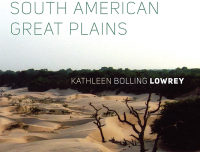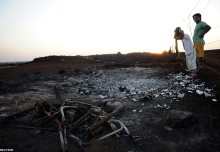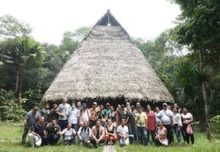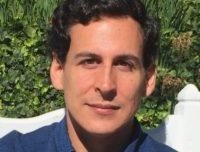
Cuicocha, Ecuador, 1997 (photo by Carlos Fausto)
Lembrança de Peter Gow
In-Memoriam (bilingual Portuguese-English)
Aparecida Vilaça
Peter Gow foi um dos antropólogos mais originais e sensíveis que conheci. A sua tese de doutorado, uma etnografia do povo Piro/Yine da Amazônia peruana, publicada em 1991 com o título de Of Mixed Blood, revolucionou – e não exagero – os estudos americanistas. No livro, Peter critica as teorias vigentes do chamado “contato interétnico” e descreve a vitalidade cultural de um povo que, em um certo quadro teórico vigente na antropologia, seria considerado “aculturado”. Esse livro teve um profundo impacto em meu trabalho com os Wari’, e pude partilhar o meu entusiasmo com os meus alunos, que foram igualmente tocados pela força da análise de Peter.
A monografia seguinte, An Amazonian Myth and its History, causou outra revolução. A análise mítica, com inspiração lévistraussiana, insere-se ali no contexto das interações cotidianas, na atenção à narrativa em si e seu contexto relacional. Com isso, Peter vai nos mostrando, aos poucos, como um mito interage com a história, relevando-a por seu contraponto, ou seja, pela obliteração dos eventos. Pelos mitos e suas transformações conhecemos a história dos Piro/Yine
An Amazonian Myth and its History foi escrito no Rio de Janeiro, mais especificamente no Cosme Velho, no apartamento alugado por Peter para uma estadia como professor visitante do Museu Nacional. Pude assistir algumas de suas aulas, que mais pareciam conversas informais com os alunos, sempre em português, que aprendeu com uma rapidez impressionante. Os livros de Peter, e seus muitos artigos, são assim também: parecem conversas, vão contando histórias, e lá no meio, quase escondidos, surgem novos conceitos, ideias e pensamentos absolutamente originais.
Com uma simpatia irradiante, Peter fazia amigos em todo lugar. Quantas vezes o ouvi contar sobre os seus compadres, comadres e afilhados Piro/Yine! Tendo iniciado a sua pesquisa de campo muito jovem, Peter viu essas crianças crescerem, convivendo com elas por quase quarenta anos. Ele fez família entre os Piro/Yine e estou certa de que eles o viam como um parente querido. Devem estar em luto agora.
Peter era um amigo querido e muito próximo. Nascemos no mesmo ano, 1958. Eu em abril e ele em junho. Brincávamos que éramos coetâneos de Madona, Michael Jackson e Prince. Tínhamos combinado de fazer uma grande viagem juntos para comemorar os nossos 50 anos. Decidimos pela Polinésia, para uma ilha chamada Morea. Cheguei a comprar minha passagem, mas Peter desistiu, acho que pressentindo a morte de sua mãe, que aconteceu logo depois.
Antes disso fizemos um monte de viagens juntos, sendo uma delas para um dos lugares mais preciosos para mim, o Aventureiro, na Ilha Grande, onde eu mesma tenho os meus compadre, comadre e afilhado. Naquela ocasião, meu filho Francisco, hoje com 30 anos, era muito pequeno. Lembro de estar sentada com Peter na porta de uma casa, com os pés na areia da praia, e Francisco ao lado, tomando leite na mamadeira. A aventura foi completa: o mar “virou” (ficou muito agitado) e nossa comida estava acabando. Decidimos andar até uma praia vizinha, Provetá, mais protegida e de onde poderíamos pegar um barco para o continente. Saimos muito cedinho e, como Francisco era pequeno, Peter ajudou a carregá-lo montanha acima. Dormimos todos em sacos de dormir em uma casa em Provetá, esperando a possível saída de um barco no dia seguinte.
Com André, meu filho mais novo, passei uma longa temporada na casa do Peter em Londres. Era uma casa em estilo vitoriano, com vitrais coloridos na parte superior da porta, azuis e vermelhos, se bem me lembro. Ficamos no quarto dos fundos, que tinha um colchão maravilhoso e era tão silencioso que me fazia dormir mais de dez horas por noite. Peter gostava de dormir tarde e me lembro de, depois do jantar, sair da sala onde estávamos conversando para colocar o André para dormir, dizendo que logo estaria de volta. Naquele quarto quentinho, eu apagava ao lado do André, e só encontrava Peter no dia seguinte. Foi naquela ocasião, em um ônibus em que voltávamos os três de uma viagem a Oxford, que André falou a sua primeira palavra: “Pete”.
Em uma visita a Cambridge, Peter me apresentou a dois antropólogos que eu admirava – e admiro – imensamente: Stephen Hugh-Jones e Marilyn Strathern, e que se tornaram interlocutores e amigos queridos. Pelas mãos de Stephen fui professora-convidada em Cambridge mais de uma vez, períodos que moldaram definitivamente a minha carreira acadêmica. Quando vivi lá, nos víamos muito e passei com ele e Francisco um aniversário memorável caminhando nas montanhas da Escócia. Os dois me deram de um desses canivetes com colher, garfo e faca para acampamento, que guardo com carinho até hoje
Vivemos juntos dois dos mais emocionantes momentos de minha vida, visitas ao escritório de Lévi-Strauss, a nossa mais importante referência intelectual. Lembro-me, no primeiro deles, de nós dois sentados em um banco em frente ao Collège de France, nervosos, fazendo hora para o horário marcado. Depois do encontro, emocionados, sentamo-nos em um café para rememorarmos ponto por ponto o que ele havia nos dito, para nos lembrarmos para sempre. À noite, fomos jantar no Marrais para comemorar.
Assim que Peter comprou a sua casa em Dundee, antes de se mudar, ele me levou para conhecê-la. Estava feliz demais em finalmente voltar para a sua terra natal, a Escócia. A casa ainda estava vazia, mas estávamos sem a chave. Eu, apertada para fazer xixi, inaugurei o seu jardim, e até recentemente nos lembrávamos disso rindo. Em outra visita, já na casa nova, Peter me convidou para conhecer a terra de seu pai e nos hospedamos no hotel mais escocês que poderia existir, com papéis de parede em xadrez verde e vermelho em todos os aposentos. Sentamo-nos à beira da lareira, comemos um jantar incrível e no dia seguinte nos encontramos para o melhor café da manhã da minha vida, que tinha até black puddiing, uma de minhas iguarias prediletas. Alguns de seus alunos foram até lá nos encontrar e caminhamos sob uma chuva fina. Todos eles, alunos e alunas, o adoravam. Além de orientador atencioso, ele os tratava como filhos, hospedando-os, preparando pratos especiais
Peter gostava de cozinhar e era um excelente cozinheiro. Não me esqueço do seu carneiro com molho de hortelã! Na última vez que nos vimos, em um jantar em sua casa em novembro de 2019, ele me contou que estava escrevendo um livro de receitas, algumas aprendidas com sua mãe (que depois recebi por email). Me deu um presente, uma tapeçaria Huichol, onde um xamã prepara uma poção em uma grande panela, ao lado de um pé de milho. Tenho-a agora na minha frente. Naquela noite fazia muito frio e fui saber que tinha sido a noite mais fria do ano. Peter não gostava de aquecimento (sou escocês, ele dizia)!
Faz frio hoje, mas agora dentro de mim. Não consigo imaginar o mundo sem o Peter. Francisco veio aqui para me fazer companhia. Eles se gostavam muito.
Em sua última visita ao Rio, Peter fez questão de conhecer a casa nova do Francisco, que organizou para nós um jantar com esfihas do árabe do Largo do Machado. Ontem relembramos esse e outros momentos. O jeito do Peter, seu riso solto , sua elegância, sempre em camisas de linho e sapatos de couro, seu jeito engraçado de exclamar “puta merda!”, e a seriedade com que ouvia as crianças e interagia com elas. Estamos todos nos sentindo órfãos.
A recipe from Peter: Mealie Pudding
(This recipe is effectively useless to you, Aparecida, since the ingredients are not available, to my knowledge, in Brazil).
This recipe was developed in dialogue with my brother.
As to Mealie Pudding, the recipe is really simple, the problem is the technology. The recipe is basically finely diced onions, grated carrots, what have you in terms of seasoning, mixed with oats (the old-fashioned cracked ones, not “porridge oats”) and suet, some water, mixed together, put into a pudding bowl and then cooked until done.
Mum’s pudding bowl was metal with a tight cap. It fitted into a large sauce pan. I wish that I possessed it. If you possess it, keep it. Mine is plastic, so has to be mediated by my steamer, which is a bit of a faffle, so basically I do not bother with mealie pudding. Which is a shame, given that it is a great recipe.
Remembrance of Peter Gow
Peter Gow was one of the most original and sensitive anthropologists I have known. His doctoral thesis, an ethnography of the Piro/Yine people of Peruvian Amazonia, published in 1991 with the title Of Mixed Blood, revolutionized—I’m not exaggerating—Americanist studies. In that book Peter critique current theories of so-called “interethnic contact” and describe the cultural vitality of a people who, in a certain realm of anthropology at the time, would be considered “acculturated.” This book had a profound impact in my work with the Wari’, and my enthusiasm was shared with my students, who were equally taken by the power of Peter’s analysis.
The monograph that followed, An Amazonian Myth and Its History, generated another revolution. The mythic analysis, with Lévistraussian inspiration, is placed in the context of everyday interactions, attending to the story itself and its relational context. With this, Peter shows us, little by little, how a myth interacts with history, revealing this history through its counterpoint, that is, through the effacement of events. Through myths and their transformations, we understand the history of the Piro/Yine.
An Amazonian Myth and Its History was written in Rio de Janeiro, more specifically in Cosme Velho neigbourhood, in an apartment Peter rented for a stay as visiting professor at the Museu Nacional. I was able to attend some of his classes, which seemed more like informal conversations with the students, always in Portuguese, which he had learned with impressive speed. Peter’s books, and his many articles, are also like that: they seem like conversations, telling stories, and then there in the middle, almost hidden, emerge new concepts, ideas, and absolutely original thoughts.
With a radiant affection, Peter made friends everywhere. How many times I heard him talk about his Piro/Yine compadres, comadres, and godchildren. Having begun fieldwork very young, Peter saw these children grow up, living with them for almost forty years. He made family among the Piro/Yine and I am sure that they see him as a beloved relative. They must be mourning now.
Peter was a dear and very close friend. We were born the same year, 1958. Me in April and he in June. We joked that we were contemporaries of Madonna, Michael Jackson, and Prince. We had arranged to make a big trip together to celebrate turning 50. We decided on Polynesia and an island called Morea. I had already bought my ticket, but Peter backed out, perhaps with presentiment of his mother’s death, which came soon after.
Before this we had made a lot of trips together, one of which was to one of the places most precious to me, Aventureiro, on Ilha Grande, where my own compadre, comadre, and godson live. On that occasion, my son Francisco, today 30 years old, was very small. I remember sitting with Peter in the door of a house, with our feet in the beach sand, and Francisco beside us drinking milk from a baby bottle. The adventure was complete: the sea “turned” (became very agitated) and our food was running out. We decided to leave and go to a neighboring beach, Provetá, more secluded and from which we could get a boat to the mainland. We left in early morning and, since Francisco was little, Peter helped carry him on his shoulders. We slept in sleeping bags in a house in Provetá, waiting for the possible departure of a boat the next day.
With André, my younger son, I had a long stay in Peter’s house in London. It was a Victorian-style house with stained glass above the door, blue and red, if I remember right. We stayed in a room upstairs, which had a marvelous mattress and was so quiet that I slept more than ten hours a night. Peter liked to sleep late, and I remember that, after dinner, I would leave the room where we had been talking to put André to sleep, saying I would come back. In that warm room, I fell asleep beside André and saw Peter only the next day. It was on that occasion, in a bus in which the three of us were returning from a trip to Oxford, that André spoke his first word: “Pete.”
On a visit to Cambridge, Peter introduced me to two anthropologists I admired—and admire—immensely: Stephen Hugh-Jones and Marilyn Strathern, who became interlocutors and dear friends. Through Stephen I became an invited professor at Cambridge more than once, periods that definitively shaped my academic career. When I lived there, we saw Peter a lot, and Francisco and I spent a memorable birthday with him walking in the Scottish Highlands. The two of them gave me one of those pocketknives with spoon, fork, knife for camping, which I keep fondly to this day.
Together we lived two of the most moving moments in my life, visits to the office of Lévi-Strauss, our most important intellectual referent. I remember, on our first visit, the two of us sitting in front of the Collège de France, nervous, marking time until the appointed hour. After our meeting, thrilled, we sat in a café recalling point by point what he had said to us, so we would always remember. That night we went to dinner in the Marais to celebrate.
As soon as Peter bought his house in Dundee, before he moved, he took me to see it. He was so happy to finally return to his birthplace, Scotland. The house was empty, but we didn’t have a key. Needing to pee, I inaugurated his garden, which we laughed about ever after. On another visit, with Peter in the new house, he invited me to get to know his father’s homeland. We stayed in the most Scottish hotel that could exist, with green and red plaid wallpaper in all the rooms. Sitting beside the fireplace, we ate an incredible dinner and the next morning had the best breakfast of my life, with black pudding, one of my favorite delicacies. Some of his students met us there and we went walking in a fine rain. All of them adored him. Besides being an attentive advisor, he treated them like his own sons and daughters, hosting them, making them special dishes.
Peter liked to cook and was an excellent cook. I’ll never forget his lamb in mint sauce! The last time we saw each other, at a dinner in November 2019 in his house, he told me he was writing a book of recipes, some learned from his mother (which I later received by email). He gave me a present, a Huichol tapestry, in which a shaman prepares a potion in a big pot next to a cornstalk. I have it in front of me right now. That night was very cold, and we learned that it was the coldest night of the year. Peter didn’t like heating (I’m Scottish, he would say!).
It’s cold today, but now the cold is inside me. I can’t imagine the world without Peter. Francisco came to keep me company. They liked each other very much. On his last visit to Rio, Peter wanted to see his new house and Francisco arranged a dinner for us of Arabic meat pies from Largo do Machado. Yesterday we were remembering these and other moments. Peter’s mannerisms, his rolling laugh, his elegance, always in linen shirts and leather shoes, his droll way of exclaiming “puta merda!”, and the seriousness with which he listed to children and interacted with them. We are all orphans now.










